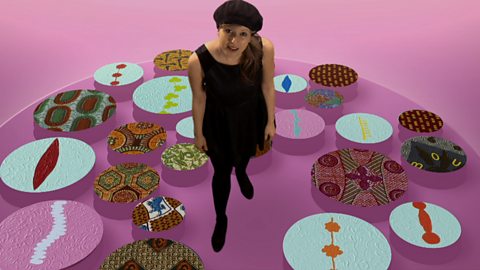Presenter: Phew! I thought they'd never leave. Have you got time to help me out? Thing is, every picture in this room's got an amazing story to tell. And the best bit is trying to figure out what that story is. This one over here is still a bit of a mystery to me.It was painted in 1434. That's nearly six hundred years ago, and people still can't agree exactly what it's about.
So, here's what I've discovered so far. It's called the "Arnolfini Portrait". And it was painted in Bruges, a city in Belgium, by a man called Jan van Eyck. So, it looks pretty simple, doesn't it? It's just two people standing in a room holding hands. But if you look really hard you realise there's a lot more going on. Luckily, van Eyck painted plenty of clues. Time to do some detective work.
INTER-DIMENSIONAL SOUND EFFECT
MUSIC: Pachelbel's Canon in D.
So, this is Arnolfini, who the painting's named after. And this… is his wife. Now, I definitely detect money here. The fancy fur-lined clothes are a big clue. And look at all this green cloth she has for her dress. In those days, the more cloth you had, the more money you had. And then there's this brass candelabra, this beautiful carpet, the mirror, and the four-poster bed! All very expensive.
And… just as I suspected. Look very closely. Oranges! Might look like Old Big Hat here has just left some fruit lying around… but in fact, oranges were a luxury then. So, really, he's showing off. Now, she looks like she's pregnant, doesn't she? And the carving over on the bedpost… is of Saint Margaret, the patron saint of childbirth. But actually, this woman isn't about to give birth. It was just the fashion then to have big round tummies. So, what are they both doing here? Well, from the way they're holding hands, looks like they could be getting married.
Hey!
Ooh, sorry(!)
No shoes…that could be a clue.Because if a wedding were happening here, the room would be made into a holy place. And, as a sign of respect, people would remove their shoes. I guess I'd better do the same. And what about their pet? The common dog name, Fido, comes from the Latin word for "trust". So, if this is a marriage, then the dog represents faithfulness. But, what if it's not a wedding?
Some people think the lit candle means life. And since there's not a candle above the woman… maybe she's not still alive. So, the painting is a way of remembering her. Whatever the answer, it's a good job van Eyck had oil paints to create all these incredible details.
Because for a long time painters had been mixing their pigments with… egg yolks. But eggs dry very quickly. So, van Eyck started using oil, which dries slowly. And this gave him more time to create realistic textures, like: the fur of the dog, the flesh of the fruit, the folds of the cloth, the shining brass, the leaves on the trees, the lace, the beads.
And here… beautiful writing painted on the wall. It's in Latin, and it means: "Jan van Eyck was here, 1434." It's a weird place to put your signature. But hold on…look in the reflection. It's so tiny. But I can just about see the backs of Arnolfini and his wife. And then behind them… two figures - I think one of them might be van Eyck! I think he really was here! Perhaps simply to paint a happy moment for two friends.
Maybe Old Big Hat is waving at van Eyck. I can imagine him, right here in front of me, working away at this beautiful picture. I'd better go before he paints me into it. Whoever you both are, I hope you had a great life together.
This painting's still quite a mystery. But the more you look, the more you'll find in a picture. I'm sure I missed some vital clues though.
CLOCK TICKS
Perhaps you'll find them.
CHIME
A statue comes to life in a magical gallery and climbs into the painting 'Arnolfini Portrait' by Jan Van Eyck, encouraging us to help her do some detective work.
Inside the painting she explores the clues that Van Eyck painted into the picture, giving us meanings behind dogs, candles and even oranges.
We learn about the techniques Van Eyck uses in his painting, and his placement within the artistic world at the time of the painting and beyond.
In a mixture of live action, animation and elements of the painting itself, the clip brings the painting to life and ends by encouraging viewers to look for more meanings and clues.
This clip is from the series Your Paintings.
Teacher Notes
This clip could be used as an introduction to the work of Jan van Eyck and/or in a discussion about famous artists, art history, or painting.
It could also be used as a stimulus for discussion of opinions and understanding.
Curriculum Notes
This clip will be relevant for teaching Art and Design at KS2 in England, Wales and Northern Ireland and at 2nd Level in Scotland.

More from Your Paintings:
Henri Rousseau’s 'Surprised!' video
Presenter-led animated examination of Henri Rousseau’s 'Surprised!', exploring the use of imagination in painting.
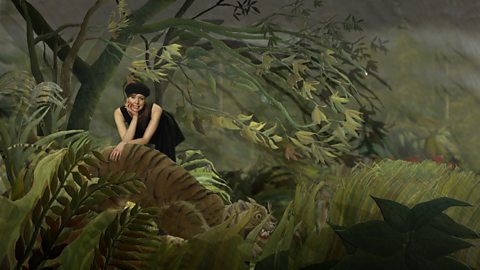
Joseph Wright of Derby’s 'Orrery' video
An examination of Joseph Wright of Derby’s 'Orrery' exploring the use of light.
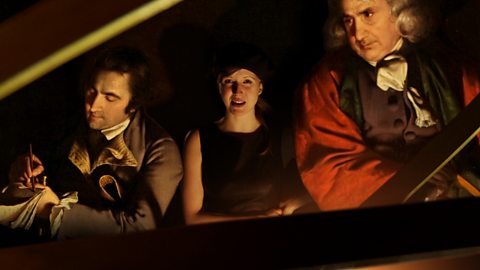
L.S. Lowry’s 'Britain at Play' video
An examination of L.S. Lowry’s 'Britain at Play' exploring style, technique and context.
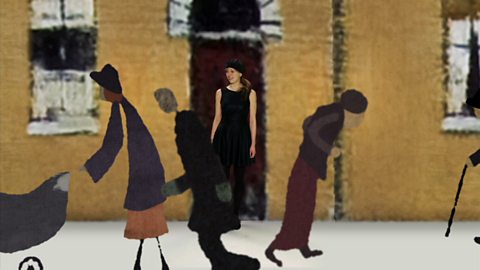
Paula Rego’s ‘Sleeping’ video
An examination of Paula Rego’s 'Sleeping' which explores storytelling through painting.

Andy Warhol’s ‘Marilyn Diptych’ video
An examination of Andy Warhol’s 'Marilyn Diptych', exploring the notion of celebrity.
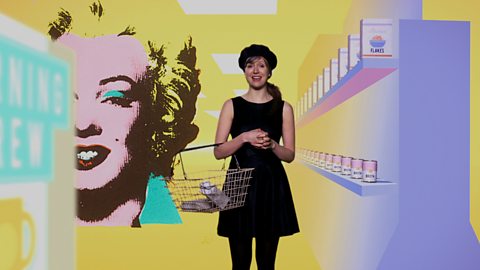
Eileen Agar’s ‘Bride of the Sea’ video
An examination of Eileen Agar’s 'Bride of the Sea', introducing surrealism and collage.
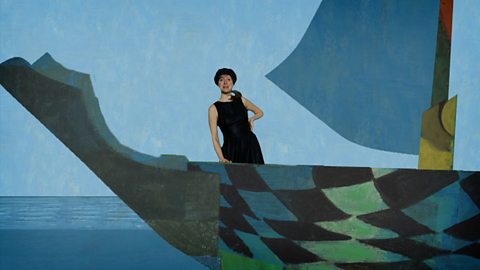
Kandinsky’s ‘Schaukeln’ video
A look at Wassily Kandinsky’s ‘Schaukeln’ which introduces abstract art and synaesthesia.
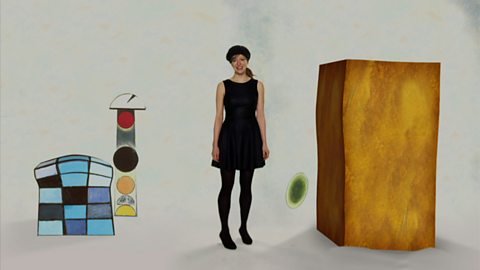
Yinka Shonibare’s ‘Line Painting’ video
Presenter-led animated look at Yinka Shonibare’s ‘Line Painting’ which introduces conceptual art and multiculturalism.
